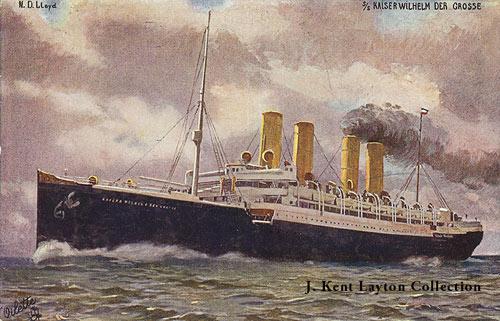Lusitania - to save the company
In 2015 we marked the centenary of the sinking of the Lusitania with a series of events, including a memorial service at Liverpool Parish church and a commemoration at the Lusitania propeller on the waterfront on Thursday 7 May. To explain why the loss of the Lusitania was such a significant event, J Kent Layton - maritime historian and author of ‘Lusitania: an illustrated biography’ - has written a series of blog posts about the history of the ship. This is the first in that series.

The German liner Kaiser Wilhelm der Grosse of 1897 © J Kent Layton Collection
At the beginning of the 20th century, the Cunard Company, or Cunard Line, was poorly positioned among its competitors in the North Atlantic trade. In 1897 the German steamship Kaiser Wilhelm der Grosse had become the largest, fastest, and most luxurious ship on the Atlantic, and a steady stream of German superliners followed in her wake. They offered unprecedented luxury to potential passengers. The British White Star line responded with their grand Oceanic of 1899; in 1902 they were bought out by American financier JP Morgan, and rolled into his International Mercantile Marine combine. White Star also put a quartet of new ocean liners into service, each of which was the largest liner in the world when they entered service between 1902 and 1907. The third ingredient in this 'perfect storm' scenario for Cunard was a prolonged rate war which broke out between the competing companies, driving ticket prices down, and cutting into vital profits.
Arthur Balfour (left) and Cunard Chairman Lord Inverclyde, the driving force
behind the creation of the Lusitania and Mauretania (right) © J Kent Layton Collection
In order to remain viable, Cunard would have to invest in building new ships that were larger and faster than anything their competitors had built or were then planning; if they didn't, the company's future was in doubt. But where were the funds to embark on such an audacious adventure to come from? Cunard's Chairman, Lord Inverclyde, approached the British Government in the hopes of securing financial assistance, basing his pitch largely on regaining British supremacy on the Atlantic. The result was a loan of £2.6 million to build two new speedsters. The ships had to be built to Admiralty standards so that they could serve as armed merchant cruisers in time of war, and would be subject to Government charter in time of war. The two new liners would be built simultaneously. Although constructed at different shipyards, they were considered sister ships, for even though there were variations between the two, they were designed from a single concept. Construction on the Lusitania commenced on 17 August 1904 at John Brown & Co on the River Clyde. Work on her sister, Mauretania, started a day later at the English firm of Swan, Hunter & Wigham Richardson on the River Tyne.
These general arrangement plans, drawn by J Kent Layton, show the Lusitania
in starboard profile, her sun and boat decks, and her hold plan. © J Kent Layton Collection
The Lusitania and Mauretania were an entirely new, and wholly unprecedented, breed of Atlantic liner. As the Lusitania was the first of the two sisters, the term 'unprecedented' is especially applicable to her. Consider several ways that this is the case. When she entered service, she would be the world's largest ship in terms of interior volume—expressed as 'gross registered tonnage'—by over 20%. She would also be the fastest, sporting a revolutionary turbine powerplant. For all of her 'firsts', copied so many times on later Atlantic liners, and for the audaciousness with which she broke the moulds of convention and implemented new technology, the Lusitania takes her rightful place as the first true superliner of the 20th century.


